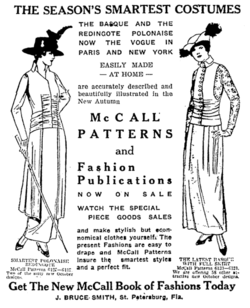Redingote

The redingote (or redingotte, redingot)[2] is a type of coat that has had several forms over time. The name is derived from a French alteration of the English "riding coat", an example of reborrowing.
Women's redingote
The first form of the redingote was in the eighteenth century, when it was used for travel on horseback. This coat was a bulky, utilitarian garment. It would begin to evolve into a fashionable accessory in the last two decades of the eighteenth century, when women began wearing a perfectly tailored style of the redingote, which was inspired by men's fashion of the time. Italian fashion also picked it up (the redingotte), adapting it for more formal occasions.
The redingote à la Hussar was trimmed with parallel rows of horizontal braid in the fashion of Hussars' uniforms.
The style continued to evolve through the late nineteenth century, until it took a form similar to today's redingote. The newer form is marked by a close fit at the chest and waist, a belt, and a flare toward the hem.
Men's redingote
The men's redingote was an eighteenth century or early nineteenth century long coat or greatcoat, derived from the country garment with a wide, flat collar called a frock In French, redingote is the usual term for a fitted frock coat. The form a men's redingote took could be of the tightly fitting frock coat style, or the more voluminous, loose "great coat" style, replete with overlapping capes or collars, such as a "garrick" redingote.
Gallery
-

Woman's redingote, c. 1790
-

1813 men's redingote
-

Redingote à la Hussar, 1817
-

Man's redingote (left), 1831
-

Redingote croisée or double-breasted frock coat, 1837
-

Redingote of 1887
-

'Redingote polonaise' (left) from a McCall advertisement, 1914
See also
Notes
References
- Cassin-Scott, Jack, Costume and Fashion in colour 1760–1920, Blandford press, ISBN 0-7137-0740-2
- Payne, Blanche: History of Costume from the Ancient Egyptians to the Twentieth Century, Harper & Row, 1965. No ISBN for this edition; ASIN B0006BMNFS
- Tozer, Jane and Sarah Levitt, Fabric of Society: A Century of People and their Clothes 1770–1870, Laura Ashley Press, ISBN 0-9508913-0-4
- Takeda,Sharon Sadako, and Kaye Durland Spilker, Fashioning Fashion: European Dress in Detail, 1700–1915, LACMA/Prestel US 2010, ISBN 978-3-7913-5062-2
External links
- Redingote at the San Jose State University nineteenth Century Paris Project
| Look up redingote in Wiktionary, the free dictionary. |
| ||||||||||||||||||||||||||||||||||||||||||||||||||||||||||||||||||||